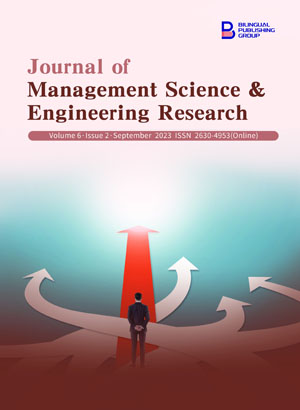-
5327
-
917
-
433
-
417
-
399
Development of Low-carbon and Sustainable Magnesium-bearing Cementitious Materials-based Solidification Approaches for Management of Problematic Soils
DOI:
https://doi.org/10.30564/jmser.v6i2.5365Abstract
The production of traditional cementitious binders such as calcium-based Portland cement poses a serious challenge to the environment and society. Therefore, low-carbon, green and sustainable magnesium-based cementitious materials are developed to replace fully or partly Portland cement and reduce the consumption of natural resources and CO2 emissions. Three interesting techniques, including reactive MgO-activated industrial solid wastes, MgObased cement and carbonation of magnesium-bearing materials, are elucidated to point to the necessity for developing novel magnesium-based cementitious materials. In the coming future, the carbonation of magnesium-rich industrial solid wastes or its combination with reactive MgO for application in various construction sectors such as soft ground improvement and concrete fabrication would be a promising approach to generate high-value products based on industrial solid wastes.
Keywords:
Mg-bearing binder; Solidification; Soil; CarbonationReferences
[1] Nicholson, P.G., Kashyap, V., Fujii, C.F., 1990. Lime and fly ash admixture improvement of tropical Hawaiian soils. Transportation Research Record. 1440, 71-77.
[2] Tremblay, H., Duchesne, J., Locat, J., et al., 2002. Influence of the nature of organic compounds on fine soil stabilization with cement. Canadian Geotechnical Journal. 39, 535-546.
[3] Zentar, R., Wang, H., Wang, D., 2021. Comparative study of stabilization/solidification of dredged sediments with ordinary Portland cement and calcium sulfoaluminate cement in the framework of valorization in road construction material. Construction and Building Materials. 279, 122447.
[4] Wang, D., Zhu, J., Wang, R., 2021. Assessment of magnesium potassium phosphate cement for waste sludge solidification: Macro and micro-analysis. Journal of Cleaner Production. 294, 126365.
[5] Gartner, E., 2004. Industrially interesting approaches to “low-CO2” cements. Cement and Concrete Research. 34(9), 1489-1498.
[6] Dung, N.T., Unluer, C., 2017. Carbonated MgO concrete with improved performance: The influence of temperature and hydration agent on hydration, carbonation and strength gain. Cement & Concrete Composites. 82, 152-164.
[7] Yi, Y., Li, C., Liu, S., et al., 2015. Magnesium sulfate attack on clays stabilised by carbide slag and magnesia-ground granulated blast furnace slag. Géotechnique Letters. 5, 306-312.
[8] Wang, D., Wang, R., Benzerzour, M., et al., 2020. Comparison between reactive MgO and Na2SO4-activated low-calcium fly ash solidified soils dredged from East Lake, China. Marine Georesources & Geotechnology. 38(9), 1046- 1055.
[9] Wang, D., Wang, H., Di, S., 2019. Mechanicalproperties and microstructure of magnesia-fly ash pastes. Road Materials and Pavement Design. 20(5), 1243-1254.
[10] Wang, D., Benzerzour, M., Hu, X., et al., 2020. Strength, permeability, and micromechanisms of industrial residue magnesium oxychloride cement solidified slurry. International Journal of Geomechanics. 20(7), 04020088.
[11] Ma, J., Zhao, Y., Wang, J., et al., 2010. Effect of magnesium oxychloride cement on stabilization/ solidification of sewage sludge. Construction and Building Materials. 24, 79-83.
[12] Wang, D., Chen, Z., Gao, X., 2022. Sustainable improvement of magnesium oxychloride cement solidified waste sludge with fly ash inclusion. Journal of Materials in Civil Engineering. 34(12), 04022317.
[13] Wang, D., Zhu, J., Zeng, G., 2022. Comprehensive evaluation on magnesium potassium phosphate cement-mineral additive stabilized waste sludge. Marine Georesources & Geotechnology. 40. doi: 10.1080/1064119X.2022.2146553.
[14] Harrison, A.J.W. (inventor), 2008. Reactive Magnesium Oxide Cements. US Patent. 7, 347, 896. 2008 Mar 25.
[15] Harrison, A.J.W. (editor), 2003. New cements based on the addition of reactive magnesia to Portland cement with or without added pozzolan. Proceedings of the CIA Conference: Concrete in the Third Millennium. Brisbane, Australia: CIA. p. 1-11.
[16] Liu, S.Y., Cai, G.H., Cao, J.J., et al., 2020. Influence of soil type on strength and microstructure of carbonated reactive magnesia-treated soil. European Journal of Environmental and Civil Engineering. 24(2), 248-266.
[17] Wang, D., Xiao, J., Gao, X., 2019. Strength gain and microstructure of carbonated reactive MgOfly ash solidified sludge from East Lake, China. Engineering Geology. 251, 37-47.
[18] Wang, D., 2021. Solidification performance and micro-structure characteristics of dredged sludge. Science Press: Beijing, China.
Downloads
How to Cite
Issue
Article Type
License
Copyright © 2023 Author(s)

This is an open access article under the Creative Commons Attribution-NonCommercial 4.0 International (CC BY-NC 4.0) License.




 Dongxing Wang
Dongxing Wang





